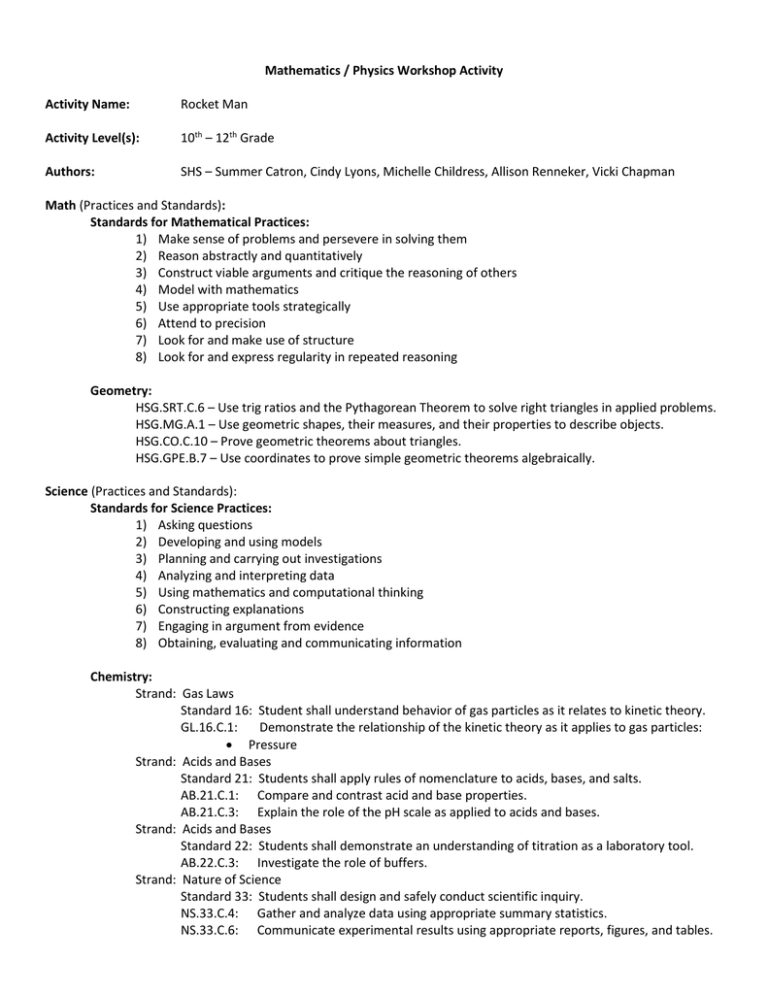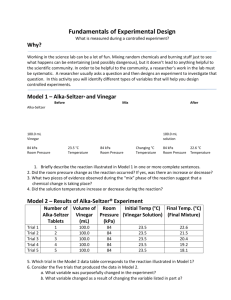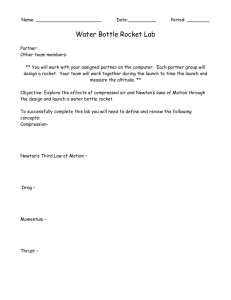Rocket Launch
advertisement

Mathematics / Physics Workshop Activity Activity Name: Rocket Man Activity Level(s): 10th – 12th Grade Authors: SHS – Summer Catron, Cindy Lyons, Michelle Childress, Allison Renneker, Vicki Chapman Math (Practices and Standards): Standards for Mathematical Practices: 1) Make sense of problems and persevere in solving them 2) Reason abstractly and quantitatively 3) Construct viable arguments and critique the reasoning of others 4) Model with mathematics 5) Use appropriate tools strategically 6) Attend to precision 7) Look for and make use of structure 8) Look for and express regularity in repeated reasoning Geometry: HSG.SRT.C.6 – Use trig ratios and the Pythagorean Theorem to solve right triangles in applied problems. HSG.MG.A.1 – Use geometric shapes, their measures, and their properties to describe objects. HSG.CO.C.10 – Prove geometric theorems about triangles. HSG.GPE.B.7 – Use coordinates to prove simple geometric theorems algebraically. Science (Practices and Standards): Standards for Science Practices: 1) Asking questions 2) Developing and using models 3) Planning and carrying out investigations 4) Analyzing and interpreting data 5) Using mathematics and computational thinking 6) Constructing explanations 7) Engaging in argument from evidence 8) Obtaining, evaluating and communicating information Chemistry: Strand: Gas Laws Standard 16: Student shall understand behavior of gas particles as it relates to kinetic theory. GL.16.C.1: Demonstrate the relationship of the kinetic theory as it applies to gas particles: Pressure Strand: Acids and Bases Standard 21: Students shall apply rules of nomenclature to acids, bases, and salts. AB.21.C.1: Compare and contrast acid and base properties. AB.21.C.3: Explain the role of the pH scale as applied to acids and bases. Strand: Acids and Bases Standard 22: Students shall demonstrate an understanding of titration as a laboratory tool. AB.22.C.3: Investigate the role of buffers. Strand: Nature of Science Standard 33: Students shall design and safely conduct scientific inquiry. NS.33.C.4: Gather and analyze data using appropriate summary statistics. NS.33.C.6: Communicate experimental results using appropriate reports, figures, and tables. Rocket Man Objectives: The student will be able to explain the properties and characteristics of vinegar and an Alka-Seltzer tablet. The student will be able to explain a chemical reaction. The student will be able to list observations that suggest a chemical reaction has taken place. The student will be able to understand Boyle’s law and apply to the volume and pressure changes at constant temperature. The student will be able to power a rocket using a chemical reaction. The student will be able to solve for missing measurements in right triangles by using trigonometric ratios. Vocabulary: Perpendicular, angle of elevation, horizontal/vertical distance, hypotenuse, height, legs, pressure, volume, chemical reaction, sine, cosine, tangent, ratio, proportion, acid, base, isosceles, scalene, equilateral, equiangular, acute, obtuse, right, Triangle Sum Theorem, Pythagorean Theorem, pH Equipment: Alka-Seltzer tablets Deionized water Measuring tape Measuring cup Vinegar Cardboard pieces Scissors Hot glue/gun Straws Protractors Weight/washers Rubber stoppers String Thermometer Tape Wood plank with dowel rod (launching pad) Prior Knowledge: 1. Factors affecting the Rate of Dissolution a. Increasing the surface area of the solute b. Agitating a solution c. Heating the solvent 2. pH table and properties 3. Pressure and Force 4. Temperature unit of Kelvin (⁰C + 273) 5. Effervescence 6. Gas Laws 7. Inverse and direct proportions in calculating math problems 8. Neutralization 9. Acids and bases 10. Chemical reactions 11. Trig functions (sine, cosine, tangent) 12. Triangle classifications 13. Using a protractor 14. Angle of elevation Procedures: Science Class (do these procedures the day before math class – student pgs. 1-3): 1) Show Speedy commercial http://www.youtube.com/watch?v=KrvywwqXo9w 2) Close reading 1 3) Question? Share with your group and come to consensus on one thing from the text you did not know before, was surprised to learn, or have a question about. Write this on your board and discuss as a class. 4) Show meatball commercial http://www.bing.com/videos/search?q=alka+seltzer+commercials&FORM=VIRE1#view=detail&mid=BF270B2CD 93EBAC66312BF270B2CD93EBAC66312 5) Close reading 2 6) Procedures for the rocket launch 7) Show example video 8) Rocket launch 9) Close reading 3 10) Science observations Math Class (do these procedures the day after science class – student pg. 4): 1) Create a visual representation of the experiment 2) Label diagram with data 3) Discuss geometric vocabulary pertaining to experiment 4) Complete supplemental worksheet Extensions: List three examples of a real life situation involving a pressure/volume relationship. Vary the amount of vinegar/water. What causes the rocket to fly higher? Vary the temperature of the water: ice water, room temperature, and heated water. Which will cause the rocket to fly higher? Vary the temperature of vinegar: ice vinegar, room temperature, and heated vinegar. Which will cause the rocket to fly higher? Vary the sizes of the rocket bottle: water bottle, 2 Liter bottle, small bottle. Which will cause the rocket to fly higher? Graph number of tablets vs. height. Graph volume vs. height and/or temperature vs. height. Add a time component to measure how long the launch takes. Writing component to check for understanding. Explore additional real-world problems involving trigonometry. Rocket Man Close Reading #1 Alka-Seltzer is an effervescent antacid that was first launched in 1931. It was marketed for the relief of minor aches, pains, cold and flu symptoms, heartburn, sour stomach, indigestion, and hangovers. In 1951, the “Speedy” character was introduced. Speedy proclaimed Alka-Seltzer’s virtues and sang the “Plop, plop, fizz, fizz” song. It aligned with that year’s promotional theme “Speedy Relief”. Alka-Seltzer’s main ingredients are aspirin, sodium bicarbonate, and citric acid. Alka-Seltzer is considered a “base” with a pH value of 9.2. (Water is considered neutral with a pH of 7) The lining of your stomach produces Hydrochloric Acid with a pH of 2-3 to aid in digestion. When there is an excess amount of acid in your stomach, you may feel discomfort, sour stomach, or acid reflux. Alka-Seltzer helps to neutralize that excess stomach acid, hence the term “antacid”. Question #1: Close Reading #2 Vinegar is a liquid consisting mainly of acetic acid and water. Vinegar is now mainly used as a cooking ingredient, but historically had a great variety of industrial, medical, and domestic uses (household cleaning). There are several varieties of vinegar such as: apple cider, balsamic, coconut, cane, and distilled vinegar to name a few. Distilled white vinegar usually measures around pH of 2.4. When the ingredient in Alka-Seltzer, sodium bicarbonate, or commonly known as baking soda, combines with vinegar, it reacts to form carbonic acid which decomposes into carbon dioxide and water. Hypothesis: When will the rocket fly the highest? 1 tablet, 2 tablets or 3 tablets? With water or vinegar? Procedure: 1. The person with the altitude finder, or clinometer, should be in place at least 12 yards from the launch pad. Record this distance in the table below. 2. Measure the height of the person holding the altitude finder, or clinometer, from the ground to his or her shoulder. Record this measurement in the table below. 3. Place 1 Alka-Seltzer tablet into the bottle. 4. Measure 1/3 cup of vinegar/water and pour into the bottle. 5. Place the rubber stopper in the bottle. 6. Shake the bottle vigorously 2-3 times. 7. Slide the straw that is attached to the bottle onto the launch pad carefully but quickly. 8. Step back out of the way! 9. The person with the altitude finder, or clinometer, should hold the clinometer straight out at shoulder height, look through the straw and follow rocket to its highest point. Press string onto protractor and read degree measurement. 10. Repeat procedures using 2 tablets and 3 tablets. Jobs: __________ A – Measurer (measure horizontal distance from the launch platform to standing point for angle finder and the height of the person using the angle finder) __________ B – Angle Finder (use clinometer to measure angle of elevation at highest point) __________ C – Launcher (places stopper on rocket, shakes mixture and places rocket on launching pad) __________ D – Mixer/Recorder (pour liquid into rocket and record all data in table) Rocket Launch (complete the following table during experiment): 1 Tablet 2 Tablets 3 Tablets Volume of Bottle (oz) 12 12 12 Amount of Vinegar/Water (c) 1/3 1/3 1/3 Horizontal Distance (yd) Liquid Temperature (K) Height of Person (yd) Angle of Elevation Close Reading #3 When a reaction takes place between vinegar and Alka-Seltzer, carbon dioxide and water is produced. Carbon dioxide is a gas. A gas molecule moves very fast and randomly. A gas molecule will move much faster than a solid or a liquid. There will be more pressure exerted to the container walls. If you shrink the volume of the container and keep the pressure constant, the container will explode. Question 2: Using the chemical reaction and the characteristics of a solid, liquid, and gas, relate this information to the rocket launch. Observation questions (science): 1) What happens when you add too much weight to the bottle? (added through different bottle designs) 2) If you were able to repeat the experiment but leave the bottle top up and bottom down, how is the result different? Why? 3) Is there any change if you don’t break up the tablet? Why or why not? 4) Would it make a difference if the liquid were a different temperature? 5) Does it make any difference if you add more Alka Seltzer® or more water? Why or why not? 6) Have you ever flown in a plane and noticed your ears pop? Why do you think this happens? 7) How could you relate this to a super soaker water gun? Draw a visual representation of your experiment: Complete the following table: 1 Tablet Lengths of all 3 sides Measure of all 3 angles Does it form a triangle? If so, classify it by sides and angles. Conclusion: Was your hypothesis correct? Explain. 2 Tablets 3 Tablets







